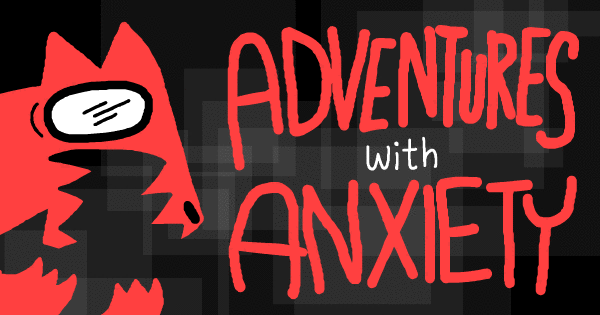How Nicky Case designed the game “Adventures with Anxiety”
Mental disorders are often considered “invisible illnesses,” as the symptoms aren’t always visible. Illustrator and game developer Nicky Case wanted to shed more light on one of the most common mental illnesses – anxiety.
With the launch of their new interactive choose-your-own-adventure style game, “Adventures with Anxiety,” Case shows just how clingy the condition can be – by depicting it as a pet wolf, ready to bite at any moment. Case spoke with Storybench, just a few days after the big launch, to discuss interactive story design and making sure we all get enough sleep.
Congratulations on the launch of your new interactive story! Can you speak to how you came up with the idea for the story, and then how you decided a game-play format was the most effective was to share it?
The metaphor of “there’s another creature in your head that represents fear” is literally millennia old. At first, I went with a wolf because I wanted the ending to be “the wolf gets domesticated into a puppy.” But, as I was working on the game, I realized that story path was boring, and more importantly it felt emotionally inauthentic to what my actual experience and slow healing with anxiety disorder was like.
I didn’t really decide a game play format was the best way to share it. Games are the medium I make. It’d be like asking a musician why they chose to share their deepest emotions as a song and not as a Medium post. That’s just the art form they use. I did try my best to use the unique strengths of the games medium for this particular story. Specifically, I could use the choices in the game to force the player to reflect on, and express, their own deepest fears and then create a healthier relationship with those fears. The game was basically one big “augmented self-reflection” tool.
During game play, the player is faced with many different options that trigger their anxiety. How did you organize the game play so that it was interactive but still followed the storyline you wrote?
I have a specific trick for this!
A common problem in interactive story design: You want a player’s choices to affect the story at each story beat. But, let’s say at each beat you only have two choices. And let’s say this story only has 10 story beats. Even with an interactive story this short, you already have 2 to the power of 10 = 1024 different endings to write. This is called “combinatoric explosion” and it’s the big problem for interactive storytelling.
My solution: Make the choices matter to the player, even if they don’t matter to the story. In Adventures With Anxiety, at each point you’re asked to choose a fear that’s most personally meaningful and relevant to you. What you pick doesn’t matter to the story. But every choice matters to you. Each chapter has one of two endings. Also, the choices you make have small “callbacks” later on, that don’t affect the main plot. In Chapter One you can warn your human about a horrible news story, and scare them into retweeting it. If you do this, in Chapter Two, two other characters will complain about a clickbait news story they saw someone retweet.
Are there alternate endings or scenarios?
The main plot is the same, but each chapter has two different endings. The biggest difference would be in Chapter 3, where – avoiding spoilers – depending on what you say to your human, something absolutely horrible happens to them, or, you successfully protect them, and they are safe.
From conception to last week’s release, how many different people were needed to work on this project? What kinds of people are needed to construct a story with audio, visuals, and a game-play element?
The game took three people in total. I did all the art and writing and almost all the code, Monplaisir did all the music. Then in the final week before the game launched, an internet pal and playtester, Spacie, found some ways to optimize the game’s performance so I hired them for a rush job in the final days.
Much of your other work, in addition to this game, use an illustrated and cartoon look. How did you come to use that technique, and why is it a hallmark for your work?
Ten years ago I started with Flash, which has the wobbly vector-graphic look. Flash’s keyboard shortcuts are entirely different from any other software, even within Adobe’s suite. So that’s why I’m still stuck using Flash, and still doing that wobbly aesthetic. Involuntarily.
What other software is needed to produce a game like this?
For the art and animation, I used Flash. For the code, Sublime Text and Google Chrome. For editing audio, Audacity.
Have you faced any barriers, in creating this game, but also in the field of storytelling with data or visualization?
In writing fiction or non-fiction, the problem that keeps coming up over and over in playtesting and test-reading is that stuff that’s obvious to you is not obvious to others. The stuff’s only obvious to you because you’ve been staring at it for months.
I noticed on the sidebar of your game, there is the full source code for free. Why is this something you provide to everyone?
When I started out in games, I benefited greatly from loads of Creative Commons music & sounds, not to mention open-source code! So, paying it forward. Besides, they’re HTML5 games. You already have the full source code in your browser.
What advice would you give to a journalism or graphic design student who may want to create their own projects, especially ones that use more than hard reporting in them, like yours about emotions?
My advice to younger folks is that “keep persevering” and “winners never quit” is f*cking terrible advice. Winners know when to quit a strategy, and dare to try other stuff instead. I started out in animation, then quit, did “traditional” minigames in Flash, then quit, and am now doing HTML5 educational game-like interactive things, and who knows, I may quit again.
The mistake is thinking “quitting” means you’re throwing it all away. You don’t. I kept the skills I learnt from animation, game design, and non-fiction explanatory writing. And now – even though I don’t use them as much as before – I still use them all in some small way. Everything you’ve learnt, even after you’ve “quit”, stays with you.
Is there anything else you would like to share, that I may have missed?
Mental health tip: sleep and wake up at the same time each day, even weekends. Seriously, don’t compromise on sleep. If natural selection decided to knock you out for a third of your life, you better bet there’s a damn good reason, to make the evolutionary cost-benefit analysis work out.
- How Nicky Case designed the game “Adventures with Anxiety” - October 7, 2019





